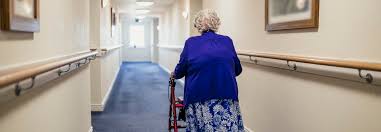 Consider the directives aimed at senior living communities. Rant on. The Washington State nursing home deaths and the virus presence in multiple nursing homes have an immediate result. Nursing home visits are now restricted nationwide – and it appears, despite lack of clarity, that also means assisted living – the combination spanning 2.5 million nationally. Most people look at the lock-downs as completely sensible, preventing the spread of the virus to such a vulnerable population. And worker shortages already plaguing this industry are expected to worsen as workers call in sick, out of fear for themselves or their families.
Consider the directives aimed at senior living communities. Rant on. The Washington State nursing home deaths and the virus presence in multiple nursing homes have an immediate result. Nursing home visits are now restricted nationwide – and it appears, despite lack of clarity, that also means assisted living – the combination spanning 2.5 million nationally. Most people look at the lock-downs as completely sensible, preventing the spread of the virus to such a vulnerable population. And worker shortages already plaguing this industry are expected to worsen as workers call in sick, out of fear for themselves or their families.
Study the Johns Hopkins sick map. Take a look at states like Florida and Arizona, which have a notable percentage of older people. Florida, a state of 21 million, has 4 million people aged 65+ and has had 106 total cases of the virus reported, with 4 deaths (only one age 65+). Arizona has an estimated population of 7.3 million people with the 65+ representing 22% of the population. The state has 12 cases, no deaths. Theories like international travel, cruises, conferences are all being circulated (and presumably investigated) as possible connections to the spread of the virus – it’s unlikely that this includes many residents of senior living. And so far, the nursing home connection (and deaths) are linked primarily to a Seattle facility.
The net result for older adults in senior living is isolation and possibly jeopardized care. Now even the oversight for monitoring care quality from family visitors is gone. What are the communication alternatives for families of residents to check on their status? And particularly, for those assisted living or nursing home residents (upwards of 50%) who have dementia? Skype? FaceTime? Seriously? Through which building window? And which staff member will take a resident to that window and hold up a tablet or their own phone? Oh and is there Wi-Fi in the community? Good luck finding that out online. (Instead you will note how many consulting organizations are offering to help with deploying a solid infrastructure.)
What happens next? The preparedness checklists are available and online. But these predate the directives to shut down visitors. Testing in nursing homes is beginning – note that the residents, not the staff, were tested in the Kirkland facility. Will there be test kits available to senior living communities everywhere to test staff so that they can be cleared to come in? Or will these only being made available in the form of drive through testing for those with symptoms to avoid further spread of the virus. If that’s the case, what about the symptom-free CNAs and other senior living workers? Ah well, maybe Google will help with communication about the virus and we can relax -- we will surely have better answers soon. Rant off.

 Consider the directives aimed at senior living communities. Rant on. The
Consider the directives aimed at senior living communities. Rant on. The